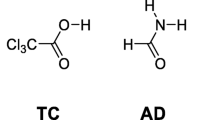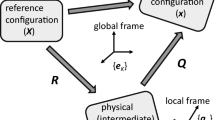Abstract
We propose some methods for quantifying the reliability of coarse-grained representations of displacement vectors of normal mode vibrations. In the framework of our basic theory, the original displacement vectors are projected onto a lower-dimensional (i.e., a coarse-grained) space. Four types of functions denoted fidelity indices were introduced as measures of the similarity of the original to the restored displacement vectors. These indices were applied to several hydrogen-bonded homodimers, and the behavior of each index was examined. We found that a coarse-grained representation with high reliability resulted in the accurate restoration of properties such as eigenfrequency, modal mass, and modal stiffness.





Similar content being viewed by others
References
Plusquellic DF, Siegrist K, Heilweil EJ, Esenturk O (2007) Applications of terahertz spectroscopy in biosystems. ChemPhysChem 8:2412–2431. https://doi.org/10.1002/cphc.200700332
Heyden M, Bründermann E, Heugen U et al (2008) Long-range influence of carbohydrates on the solvation dynamics of water—answers from terahertz absorption measurements and molecular modeling simulations. J Am Chem Soc 130:5773–5779. https://doi.org/10.1021/ja0781083
Williams MRC, True AB, Izmaylov AF et al (2011) Terahertz spectroscopy of enantiopure and racemic polycrystalline valine. Phys Chem Chem Phys 13:11719–11730. https://doi.org/10.1039/c1cp20594c
Taday PF, Bradley IV, Arnone DD, Pepper M (2003) Using terahertz pulse spectroscopy to study the crystalline structure of a drug: a case study of the polymorphs of ranitidine hydrochloride. J Pharm Sci 92:831–838. https://doi.org/10.1002/jps.10358
Zhang F, Kambara O, Tominaga K et al (2014) Analysis of vibrational spectra of solid-state adenine and adenosine in the terahertz region. RSC Adv 4:269. https://doi.org/10.1039/c3ra44285c
Giraud G, Wynne K (2003) A comparison of the low-frequency vibrational spectra of liquids obtained through infrared and Raman spectroscopies. J Chem Phys 119:11753–11764. https://doi.org/10.1063/1.1623747
Della Valle GR, Venuti E et al (2004) Intramolecular and low-frequency intermolecular vibrations of pentacene polymorphs as a function of temperature. J Phys Chem B 108:1822–1826. https://doi.org/10.1021/jp0354550
Luckhaus D (2010) Hydrogen exchange in formic acid dimer; tunneling above the barrier. Phys Chem Chem Phys 12:8357–8361. https://doi.org/10.1039/c001253j
Xue Z, Suhm MA (2009) Probing the stiffness of the simplest double hydrogen bond: the symmetric hydrogen bond modes of jet-cooled formic acid dimer. J Phys Chem 131:054301. https://doi.org/10.1063/1.3191728
Müller A, Talbot F, Leutwyler S (2001) Intermolecular vibrations of the jet-cooled 2-pyridone·2-hydroxypyridine mixed dimer, a model for tautomeric nucleic acid base pairs. J Chem Phys 115:5192–5202. https://doi.org/10.1063/1.1394942
Muller A, Talbot F, Leutwyler S (2000) Intermolecular vibrations of jet-cooled (2-pyridone)2: a model for the uracil dimer. J Chem Phys 112:3717–3725
Müller A, Talbot F, Leutwyler S (2002) S1/S2 exciton splitting in the (2-pyridone)2 dimer. J Chem Phys 116:2836–2847. https://doi.org/10.1063/1.1434987
Taddei G, Bonadeo H, Marzocchi MP, Califano S (1973) Calculation of crystal vibrations of benzene. J Chem Phys 58:966–978
Neto N, Righini R, Califano S (1978) Lattice dynamics of molecular crystals using atom-atom and multipole-multipole potentials. Chem Phys 29:167–179
Zhang F, Wang H, Tominaga K, Hayashi M (2016) Mixing of intermolecular and intramolecular vibrations in optical phonon modes: terahertz spectroscopy and solid-state density functional theory. WIREs Comput Mol Sci 6:386–409. https://doi.org/10.1002/wcms.1256
Day GM, Zeitler JA, Jones W et al (2006) Understanding the influence of polymorphism on phonon spectra: lattice dynamics calculations and terahertz spectroscopy of carbamazepine. J Phys Chem B 110:447–456
Day GM (2011) Current approaches to predicting molecular organic crystal structures. Cryst Rev 17:3–52. https://doi.org/10.1080/0889311X.2010.517526
Zhang F, Hayashi M, Wang HW et al (2014) Terahertz spectroscopy and solid-state density functional theory calculation of anthracene: effect of dispersion force on the vibrational modes. J Chem Phys 140:174509. https://doi.org/10.1063/1.4873421
Zhang F, Wang H-W, Tominaga K, Hayashi M (2015) Intramolecular vibrations in low-frequency normal modes of amino acids: L-alanine in the neat solid state. J Phys Chem A 119:3008–3022. https://doi.org/10.1021/jp512164y
Williams MRC, Aschaffenburg DJ, Ofori-Okai BK, Schmuttenmaer CA (2013) Intermolecular vibrations in hydrophobic amino acid crystals: experiments and calculations. J Phys Chem B 117:10444–10461. https://doi.org/10.1021/jp406730a
Houjou H (2009) Coarse graining of intermolecular vibrations by a Karhunen-Loève transformation of atomic displacement vectors. J Chem Theor Comput 5:1814–1821. https://doi.org/10.1021/ct900169f
Houjou H (2011) Evaluation of coupling terms between intra- and intermolecular vibrations in coarse-grained normal-mode analysis: does a stronger acid make a stiffer hydrogen bond? J Chem Phys 135:154111. https://doi.org/10.1063/1.3652102
Houjou H (2017) Modelling intra- and intermolecular vibrations under the harmonic oscillator approximation: from symmetry-adapted to coarse-grained coordinate approaches. J Math Chem 55:532–551. https://doi.org/10.1007/s10910-016-0692-x
Wilson Jr EB, Decius JC, Cross PC (1980) Molecular vibrations. Dover, New York
Frisch MJ, Trucks GW, Schlegel HB, et al (2013) Gaussian 09w, revision D. Gaussian Inc., Wallingford
Jmol Development Team (2018) Jmol: an open-source Java viewer for chemical structures in 3D. http://www.jmol.org/
Acknowledgements
This work was supported (in part) by a Grant for Basic Science Research Project in the fiscal year of 2016 received from The Sumitomo Foundation.
Author information
Authors and Affiliations
Corresponding author
Appendix: Definition of the coarse-graining matrix
Appendix: Definition of the coarse-graining matrix
Based on our previous formulation, we can write matrix \( \overset{\sim }{\mathbf{B}} \) to transform the atomic displacement vectors of an X-meric molecular assembly from a Cartesian to an internal coordinate system as Eq. A1. Provided that the constituent molecules are nonlinear, matrix \( \overset{\sim }{\mathbf{B}} \) is composed of \( {\mathbf{B}}_m^{{}^{\circ}}, \) representing twelve basic motions, including six translational modes (Tx, Ty, Tz) and six rotational modes (Rx, Ry, Rz). bm is a set of vibrational motions selected from the first to the (3Nm − 6)th normal mode, where m designates the constituents I, II, ..., X.
To construct an appropriate \( \overset{\sim }{\mathbf{B}} \) matrix, we need to choose the set of vectors bm that best represents the intramolecular vibrational motions, as extracted from the results of normal mode analysis for the constituent in its isolated state. However, there is a slight difference between the optimized structure of a constituent in its isolated state and its optimized structure in a molecular assembly. To reduce errors resulting from this discrepancy, we adopted a method to adjust the molecular orientation, namely arranging the principal axes of inertia (a, b, c) of a constituent molecule in its isolated state to coincide with those in the molecular assembly. Under this coordination setting, submatrix \( {\mathbf{B}}_m^{{}^{\circ}} \) cannot be uniquely determined, but there is an arbitrariness with respect to the definition of the rotating axes. Even though matrix \( \overset{\sim }{\mathbf{B}} \) is not necessarily orthogonal, the MWD vectors (columns in M1/2\( \overset{\sim }{\mathbf{B}} \)) will be orthogonal when the rotational axes of a constituent coincide with its principal axes of inertia, and only then will Γ−1 = \( \overset{\sim }{\mathbf{B}} \)TM\( \overset{\sim }{\mathbf{B}} \) become diagonal. Even when they do not coincide with each other, the definitions of the axes of translation (x, y, z) and rotation (a, b, c) do not influence the reliability of coarse-graining. We should note that the parameters obtained (stiffness and inertial load) are represented based on the given coordinate system and designated as matrix elements like components (Tx, Tx) or (Ra, Rb). Similar attention should be paid when we construct the C matrix. The first six columns of C cannot be uniquely determined, but there is an arbitrariness with respect to the definition of the axes of rotation. The MWD vectors (columns in W = M1/2C) are orthogonal to each other only when the rotational axes of the molecular assembly coincide with the principal axes of inertia. Although the definitions of the axes of translation and rotation do not affect the result of the coarse-graining calculation, the orthogonality of W influences matrix R and hence the maximum values of the fidelity indices F1 to F4.
For example, the matrix for a dimeric molecular system is given by
In our previous studies [21,22,23], we used \( {\overset{\sim }{\mathbf{B}}}_{Ci} \) specified for a molecular dimer with Ci symmetry. However, this treatment does not greatly affect the result because \( {\overset{\sim }{\mathbf{B}}}_{Ci} \) and \( \overset{\sim }{\mathbf{B}} \) are connected by the following relation:
using the symmetry-adapted transformation PCi composed of the (6 + v) × (6 + v) unit matrix E (v is the number of intramolecular vibrational modes included in the basis set):
If we use \( \overset{\sim }{\mathbf{B}} \) to obtain the various matrices (stiffness, inertial load, displacement, and mass-weighted displacement), the parameters are designated as matrix elements like (Tx, Tx) and (Ra, Rb) components. Using the PCi matrix, we can transform them to the corresponding values for a given coordination system such as the Ci-specific coordination system in which the parameters are designated like (Tx – Tx, Tx – Tx) or (Ra + Ra, Rb – Rb) components:
Using an appropriate transformation matrix P, we can also redefine the directions of the x, y, and z axes in order to conveniently clarify the physical meaning of an obtained parameter (e.g., the stiffness of a specific hydrogen bond). In the present study, we defined the xy plane as the least-squares plane of the four atoms participating in the double hydrogen bond and the x-axis as the average of two hydrogen-bonding vectors projected onto the xy plane. Since the obtained parameters of stiffness are represented based on a non-symmetry-adapted coordinate system, those corresponding to translation along the x-axis are designated ΦTx,Tx.
Rights and permissions
About this article
Cite this article
Isogai, M., Houjou, H. Indices to evaluate the reliability of coarse-grained representations of mixed inter/intramolecular vibrations. J Mol Model 24, 221 (2018). https://doi.org/10.1007/s00894-018-3757-x
Received:
Accepted:
Published:
DOI: https://doi.org/10.1007/s00894-018-3757-x




